Accepted Scientific Name: Cereus hildmannianus
Fl. Bras. (Martius) 4(2): 202; et in Monats. fur Kakteenk. ii. (1892) 55cum ic. 1898
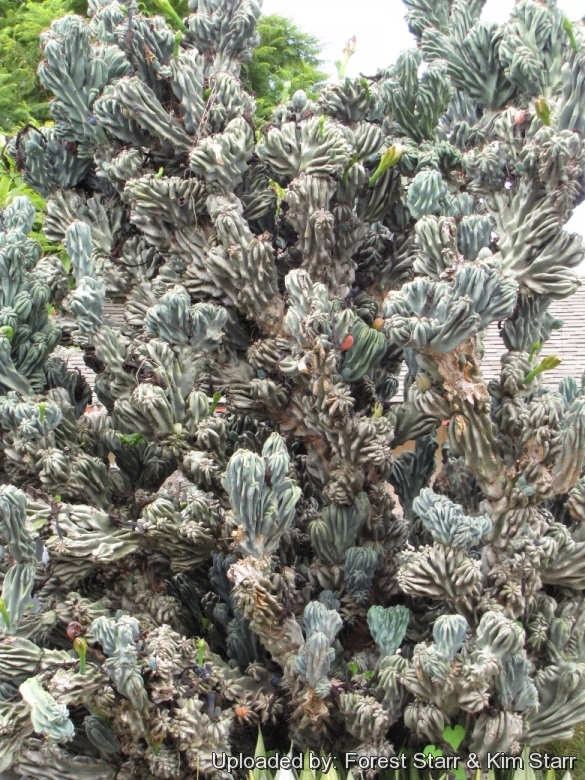
Cereus hildmannianus f. cristata monstruosa Photo by: Forest Starr & Kim Starr
(Peruvianus Crest Monstrosus) habit at Kihei, Maui, Hawaii (USA). August 18, 2009.
Origin and Habitat: Garden origin
Synonyms:
See all synonyms of Cereus hildmannianus
back
Accepted name in llifle Database:Cereus hildmannianus K.Schum.Fl. Bras. (Martius) 4(2): 202; et in Monats. fur Kakteenk. ii. (1892) 55cum ic. 1898Synonymy: 18
Accepted name in llifle Database:Cereus hildmannianus subs. uruguayanus (R.Kiesling) N.P.TaylorCactaceae Consensus Init. 6: 15. 1998Synonymy: 3
back
Description: Cereus hildmannianus f. cristata monstruosaSN|28484]]SN|28484]] (a.k.a. C. peruvianus montruosus) is a teratological (monstrous mutant) cactus form (or cultivar) that grows into a tight bunch of twisted stems with irregular ribs and more or less crested growing points. There are several other crested Cereus clones that have a tendency to fan out, but the Cereus hildmannianus f. cristata monstruosaSN|28484]]SN|28484]] is surely one of the best form available. Due to its large size it make a spectacular attraction also in pots in the greenhouse or yard and outdoor in the garden too.
Habit: This cactus forms a huge crowded and variously shaped heap of stems 0.5-3 (or more) meters tall and wide (depending on clone and growing conditions) and looks more like a giant green coral tree than a cactus and shows different crested and monstrous shapes.
Note: Cereus hildmannianus f. cristata monstruosaSN|28484]]SN|28484]] cactus is generally increased from cuttings. However, on sowing seed, a proportion of seedlings show the same monstrous condition. Whichever way propagation is carried out, the same name is to be applied to the monstrous plants that form the cultivar, moreover there are several clones shoving different degrees of monstrosity all referable to the same cultivar name. The non-monstrose plants raised from seeds collected on monstrous parents are treated as indistinguishable parts of the species.
Subspecies, varieties, forms and cultivars of plants belonging to the Cereus hildmannianus group
Bibliography: Major references and further lectures
1) International Society for Horticultural Science, International Commission for the Nomenclature of Cultivated Plants “International code of nomenclature for cultivated plants: (I.C.N.C.P. or cultivated plant code) : incorporating the rules and recommendations for naming plants in cultivation” International Society for Horticultural Science, 2004
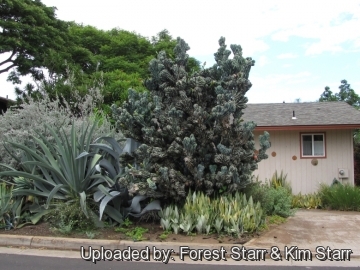 (Peruvianus Crest Monstrosus) Habit at Kihei, Maui, Hawaii (USA). August 18, 2009. Photo by: Forest Starr & Kim Starr
(Peruvianus Crest Monstrosus) Habit at Kihei, Maui, Hawaii (USA). August 18, 2009. Photo by: Forest Starr & Kim Starr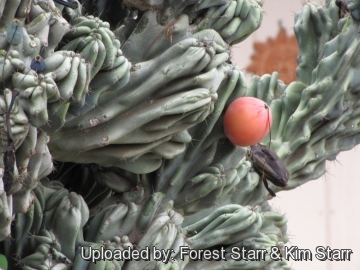 (Peruvianus Crest Monstrosus) fruit at Kihei, Maui, Hawaii (USA). August 18, 2009. Photo by: Forest Starr & Kim Starr
(Peruvianus Crest Monstrosus) fruit at Kihei, Maui, Hawaii (USA). August 18, 2009. Photo by: Forest Starr & Kim Starr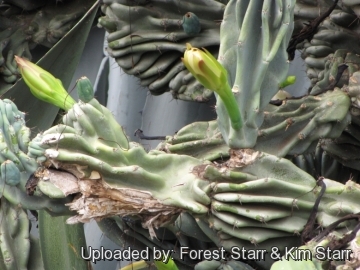 (Peruvianus Crest Monstrosus) flowers at Kihei, Maui, Hawaii (USA). August 18, 2009. Photo by: Forest Starr & Kim Starr
(Peruvianus Crest Monstrosus) flowers at Kihei, Maui, Hawaii (USA). August 18, 2009. Photo by: Forest Starr & Kim Starr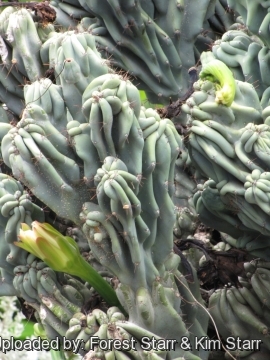 (Peruvianus Crest Monstrosus) flowers at Kihei, Maui, Hawaii (USA). August 18, 2009. Photo by: Forest Starr & Kim Starr
(Peruvianus Crest Monstrosus) flowers at Kihei, Maui, Hawaii (USA). August 18, 2009. Photo by: Forest Starr & Kim StarrCultivation and Propagation: Cereus hildmannianus f. cristata monstruosaSN|28484]]SN|28484]] is well known to cactus fanciers throughout the world. It is very easy to cultivate and easy to propagate.
Growth rate: It grows quickly (a young plant will easily grow more than a 20 cm per year) and a plant grown in loose fertile soil with ample water availability may get up to several metres tall with hundreds of branches in only 10 years.
Soils: For pot culture it needs standard cactus soil. Outdoors needs well drained spots, with deep soil, but will still thrive in less than ideal conditions. The species is sensitive to salinity.
Repotting: Since they are big-sized plants, they need plenty of space for their roots. Repotting should be done every other year, or when the plant has outgrown its pot. Use pot with good drainage.
Watering: Water regularly in summer, but do not overwater and allow to dry fully before watering again. Its roots are easily lost in pots that stay damp for any length of time. It should not be watered at all in winter. In the rest period no high atmospheric humidity!! Care must be taken with watering as they tends to become swollen and untidy in growth habit if given too much water and shade.
Fertilization: During the growing season enrich the soil using a fertilizer rich in potassium and phosphorous, but poor in nitrogen, because this chemical element doesn’t help the development of succulent plants, making them too soft and full of water.
Hardiness: Reputedly sensitive to frost , but less so if kept on the dry side prior to, and during, cold weather (hardy to -5° C for short periods). However some warmth throughout the year will increase the grower's success (minimum 5° to 8°C during rest season). In presence of high atmospheric humidity make sure that your saguaros are not exposed to freezing temperatures, or they may die. Outdoors this plant is very adaptable, as long as you avoid excessive humidity in the winter months.
Exposition: Light shade when young, full sun later. Outside it likes strong sunshine, but is tolerant and do well with light shade during the hot Summer months, inside it needs bright light, and some direct sun.
Garden uses: Excellent as landscape or patio plant. It is suitable for “desert” gardens, in association with other xerophytes. Where the open air cultivation is not possible due to the climate, it is to be cultivated in pot in order to shelter it in winter. It look fine in a cold greenhouse and frame.
Pests & diseases: It may be attractive to a variety of insects, but plants in good condition should be nearly pest-free, particularly if they are grown in a mineral potting-mix, with good exposure and ventilation. Nonetheless, there are several pests to watch for:
- Red spiders: Sensitive to red spider mite. Overhead watering is helpful in controlling mites.
- Mealy bugs: Occasionally mealy bugs they develop aerial into the new growth among the wool with disfiguring results, but the worst types develop underground on the roots and are invisible except by their effects.
- Scales: Scales are rarely a problem.
- Rot: Rot it is only a minor problem with cacti if the plants are watered and “aired” correctly. If they are not, fungicides won't help all that much.
Propagation: From cuttings in spring (let them dry till the ends callous well). Then replant them in fresh cactus soil that is ever so slightly moist, and keep them that way till they root). The cuttings grow rapidly into a large specimens.















